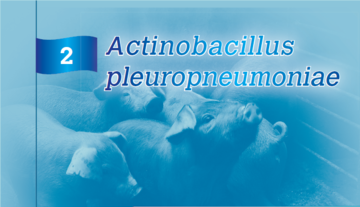The forms of pleurisy located in the dorso-caudal region are primarily caused by Actinobacillus pleuropneumoniae (A.p.) and to a lesser extent by other pathogens.
A.p. is responsible for serious acute clinical disease characterized from a patho-anatomical standpoint by cases of fibrino-necrotic-haemorrhagic pleuropneumonia, with variable mortality in animals afflicted according to the virulence of the serotype involved.
Figure 2: Pig lungs - Cases of fribrous dorso-caudal pleurisy, likely associated with A.p.
The chronic form of the infection is characterized by the development of chronic lung lesions appearing as fibrous pleurisy of variable gravity at the dorso- caudal side of lungs that can seriously impair the animal’s productive career. This is because the dorsal pleural lesions, even more than the apical lesions, impose a mechanical limitation and a level of pain during the animals’ respiratory movements that result in reduced daily weight gain and an increased number of days necessary for reaching slaughter weight.
The chronic pleural lesions, still present at the time of slaughter, can be easily observed in this context and provide key information regarding the health conditions of the farm, the timeliness of undertaking control measures or for assessing the results obtained by implementing them.
...
<< Back to Lung Scoring Methodology
Related topics: a.p. actinobacillus pleuropneumoniae ceva lung program swine lung scoring pleuropneumonia

 Corporate Website
Corporate Website
 Africa
Africa
 Argentina
Argentina
 Asia
Asia
 Australia
Australia
 Belgium
Belgium
 Brazil
Brazil
 Bulgaria
Bulgaria
 Canada (EN)
Canada (EN)
 Chile
Chile
 China
China
 Colombia
Colombia
 Denmark
Denmark
 Egypt
Egypt
 France
France
 Germany
Germany
 Greece
Greece
 Hungary
Hungary
 Indonesia
Indonesia
 Italia
Italia
 India
India
 Japan
Japan
 Korea
Korea
 Malaysia
Malaysia
 Mexico
Mexico
 Middle East
Middle East
 Netherlands
Netherlands
 Peru
Peru
 Philippines
Philippines
 Poland
Poland
 Portugal
Portugal
 Romania
Romania
 Russia
Russia
 South Africa
South Africa
 Spain
Spain
 Sweden
Sweden
 Thailand
Thailand
 Tunisia
Tunisia
 Turkey
Turkey
 Ukraine
Ukraine
 United Kingdom
United Kingdom
 USA
USA
 Vietnam
Vietnam





